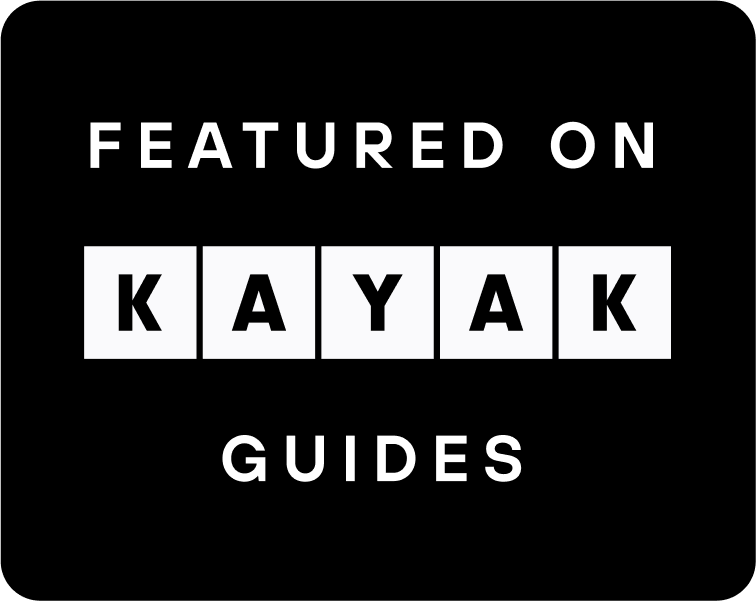Looking & Seeing
one long look at one work of art
John O'Hern is an arts writer, curator and retired museum director who is providing a weekly contemplation of a single work of art from our gallery. In our fast-paced lives overflowing with information, we find it necessary and satisfying to slow down and take time to look. We hope you enjoy this perspective from John.
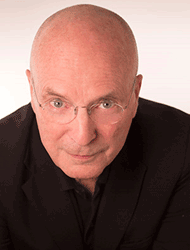
John O'Hern has been a writer for the 5 magazines of International Artist Publishing for nearly 20 years. He retired from a 35-year-long career in museum management and curation which began at the Albright-Knox Art Gallery where he was in charge of publications and public relations and concluded at the Arnot Art Museum where he was executive director and curator. At the Arnot Art Museum he curated the groundbreaking biennial exhibitions Re-presenting Representation. John was chair of the Visual Artists Panel of the New York State Council on the Arts and has written essays for international galleries and museums.
January 12, 2025
ESHA CHIOCCHIO | First Tracks II
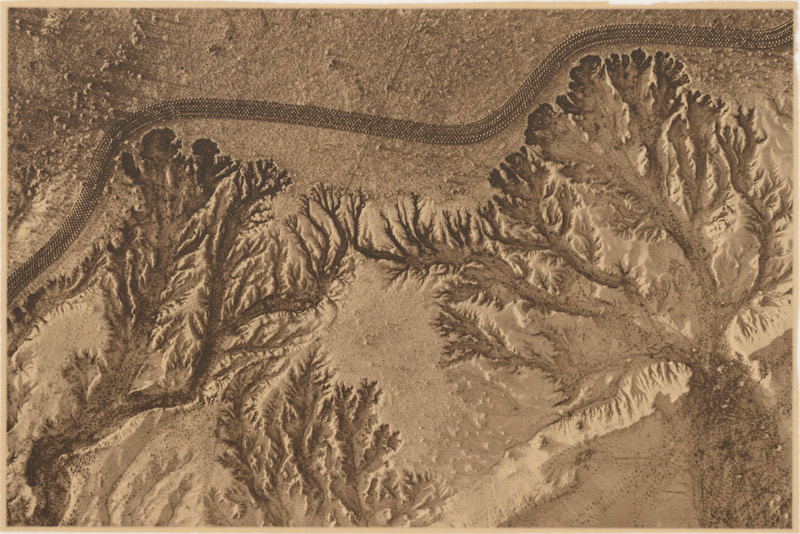
Esha Chiocchio says, “I think of soil as a very precious thing and am interested in soil and land restoration, healing the damage people have done on this planet.”
Her photographs document the traditional annual remudding of the Great Mosque of Djenné, Mali, West Africa, for “National Geographic Magazine” and the rebuilding of miles of grasslands in the Lordsburg Playa in southwestern New Mexico for which she was awarded a 2023 National Geographic Explorer storyteller grant.
The mud buildings of Djenné suit their environment with thick walls that make cool interior spaces. The torrential downpours of the rainy season ravage the mud, however, and it needs to be replenished each year. Esha describes the work as “a slippery, messy scene with mud flying in all directions, people yelling instructions, kids laughing, people chanting – community chaos at its best.” Esha was a Peace Corps volunteer in Mali in 1997-1999.
She notes different conditions at Lordsburg. “In the late 1880s, when settlers founded Lordsburg in Southwestern New Mexico, a sea of grass tickled their horses' bellies and provided ample feed for their growing herds of livestock. By 2015, cattle had eaten the grass to the ground, and dust storms frequently enveloped Interstate 10, causing over 40 fatalities along a 20-mile stretch of highway since 1965.”
The entire community comes together to remud the Great Mosque and a handful of people are working with government agencies to restore the tickling grass of Lordsburg.
In both cases, in addition to the work itself, Esha is captivated by the people doing the work. Her photographs are “stories of hope, people doing things to shift our direction.”
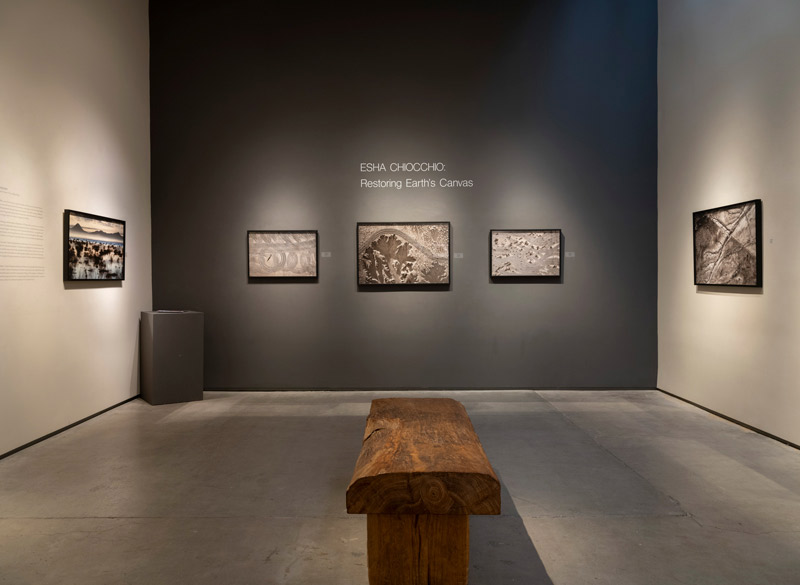 We spoke at length about photography as fine art. At various points in my career I’ve beat the drum for photography as fine art and craft (pottery, glass, weaving, etc.) as fine art, including all of it in exhibitions of paintings drawings and sculpture. We couldn’t come up with a definition of “fine art” but agreed that Kathrine Erickson perhaps elevated documentary photography into that realm with the exhibition of Esha’s photographs, Restoring Earth’s Canvas, in 2023.
We spoke at length about photography as fine art. At various points in my career I’ve beat the drum for photography as fine art and craft (pottery, glass, weaving, etc.) as fine art, including all of it in exhibitions of paintings drawings and sculpture. We couldn’t come up with a definition of “fine art” but agreed that Kathrine Erickson perhaps elevated documentary photography into that realm with the exhibition of Esha’s photographs, Restoring Earth’s Canvas, in 2023.
Esha did come close to a definition, though, when she said, “Fine art for me is an image that has an engaging power to it such that a person wants to linger on that image.”
Among the photographs in the exhibition was First Tracks II, an aerial shot from her drone showing the erosion of the playa and a mysterious patterned ribbon along the top of the image. The photo is an intimate 6 x 9” pigment print with Moon Gold leaf on archival Mylar.
Moon Gold leaf is a blend of gold, silver and palladium with a softer color than gold leaf made with gold and copper. She explains that it “gives the land a luminance worthy of its profound importance to our collective future.”
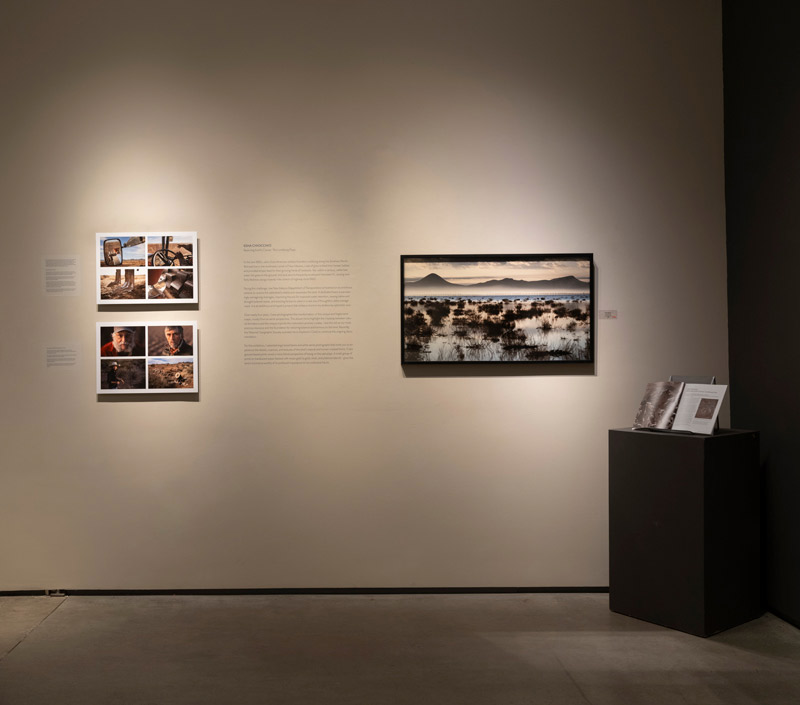 The mysterious patterned ribbon is the mark making of Gordon Tooley, one of the three dedicated environmentalists working to restore the Playa. He is the proprietor of Tooley’s Trees and Keyline Design in Truchas, NM. His mark making takes place in three stages: first, he recontours the land with a keyline plow that oxygenates the soil, then uses a seeder and then an imprinter that makes pockmarks to capture rainfall.
The mysterious patterned ribbon is the mark making of Gordon Tooley, one of the three dedicated environmentalists working to restore the Playa. He is the proprietor of Tooley’s Trees and Keyline Design in Truchas, NM. His mark making takes place in three stages: first, he recontours the land with a keyline plow that oxygenates the soil, then uses a seeder and then an imprinter that makes pockmarks to capture rainfall.
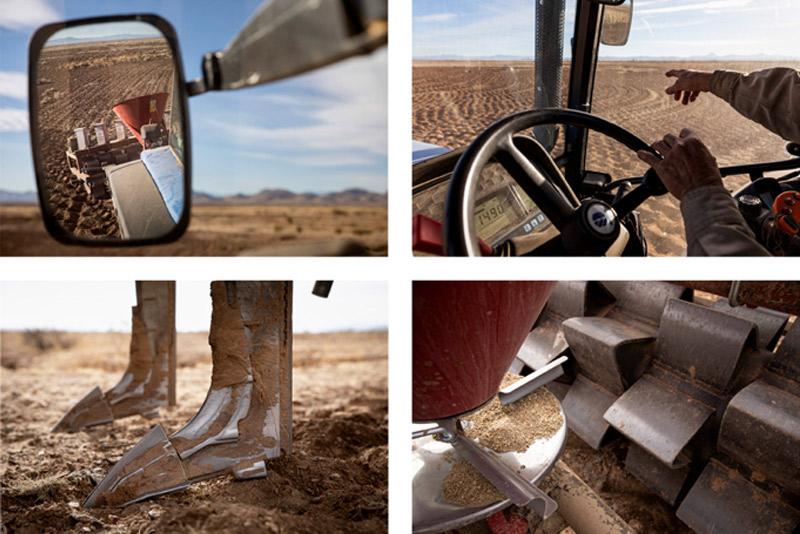 When I asked her why, among a predominantly black and white exhibition, her portraits of the environmentalists were in color, she immediately replied that “these are colorful people and Gordon was wearing a deep red flannel shirt”.
When I asked her why, among a predominantly black and white exhibition, her portraits of the environmentalists were in color, she immediately replied that “these are colorful people and Gordon was wearing a deep red flannel shirt”.
Mike Gaglio owns High Desert Native Plants, in El Paso, TX, and selected gamma grasses, alkali sacaton, fourwing saltbush and len-scale saltbush for the project, all suited to the harsh terrain.
Van Clothier owns Stream Dynamics in Silver City, NM, and works to restore damaged watersheds. In her article on Esha and the Lordsburg project for “Evokation”, Kate Nelson quotes Van Clothier: “We work seamlessly together. We work, we camp, we have yummy food. We have beautiful sunrises and sunsets. We’ve watched rains and storms, seen the tremendous success of the project—and we’re having the time of our lives out there.”
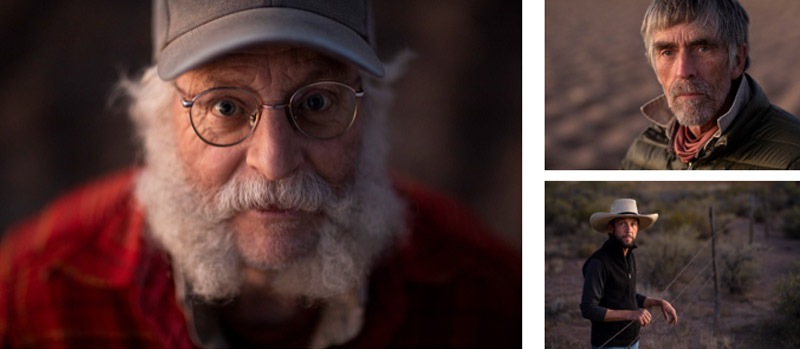 Esha has a Master of Arts degree in Sustainable Communities from Goddard College. “I was interested in sustainable communities,” she explains, “investigating how do we regenerate the earth and make it beautiful and whole. But, photography kept calling me back to it after my husband and I raised our family. It feeds my soul on a certain level. I want to tell stories—stories of hope and of people doing things to shift our direction.”
Esha has a Master of Arts degree in Sustainable Communities from Goddard College. “I was interested in sustainable communities,” she explains, “investigating how do we regenerate the earth and make it beautiful and whole. But, photography kept calling me back to it after my husband and I raised our family. It feeds my soul on a certain level. I want to tell stories—stories of hope and of people doing things to shift our direction.”
Mike Gaglio summed up Esha’s talent in Kate Nelson’s essay: “This is a tough site to be on. It takes a special person to see the beauty. It takes work. Esha’s pictures are so deep. There’s such a soul to them.”
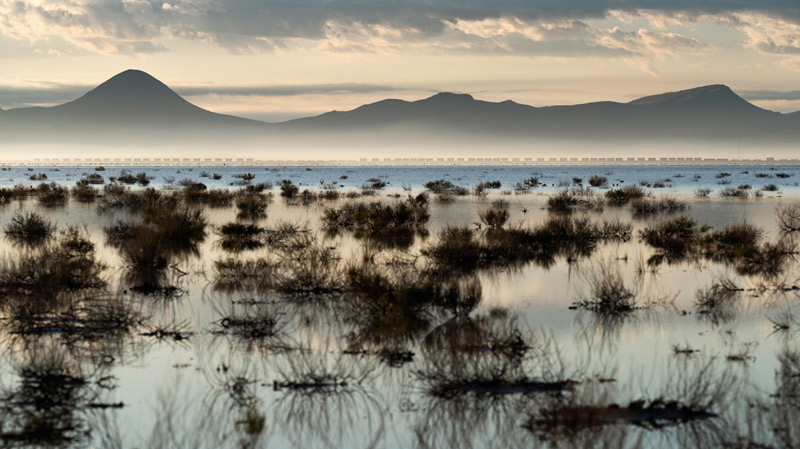 “Another photo in the exhibition was Morning Train, a color, archival pigment print, 40-inches wide of the Playa after a rain. Esha says “The train image needs to be large to be read properly. I got up early and went out to see what was going on. There was fog that morning and a train was passing in the distance. It was trains that opened up the land for ranchers and allowed them to get their cattle out to market. Heavy grazing consequently caused the grasslands to virtually disappear.”
“Another photo in the exhibition was Morning Train, a color, archival pigment print, 40-inches wide of the Playa after a rain. Esha says “The train image needs to be large to be read properly. I got up early and went out to see what was going on. There was fog that morning and a train was passing in the distance. It was trains that opened up the land for ranchers and allowed them to get their cattle out to market. Heavy grazing consequently caused the grasslands to virtually disappear.”
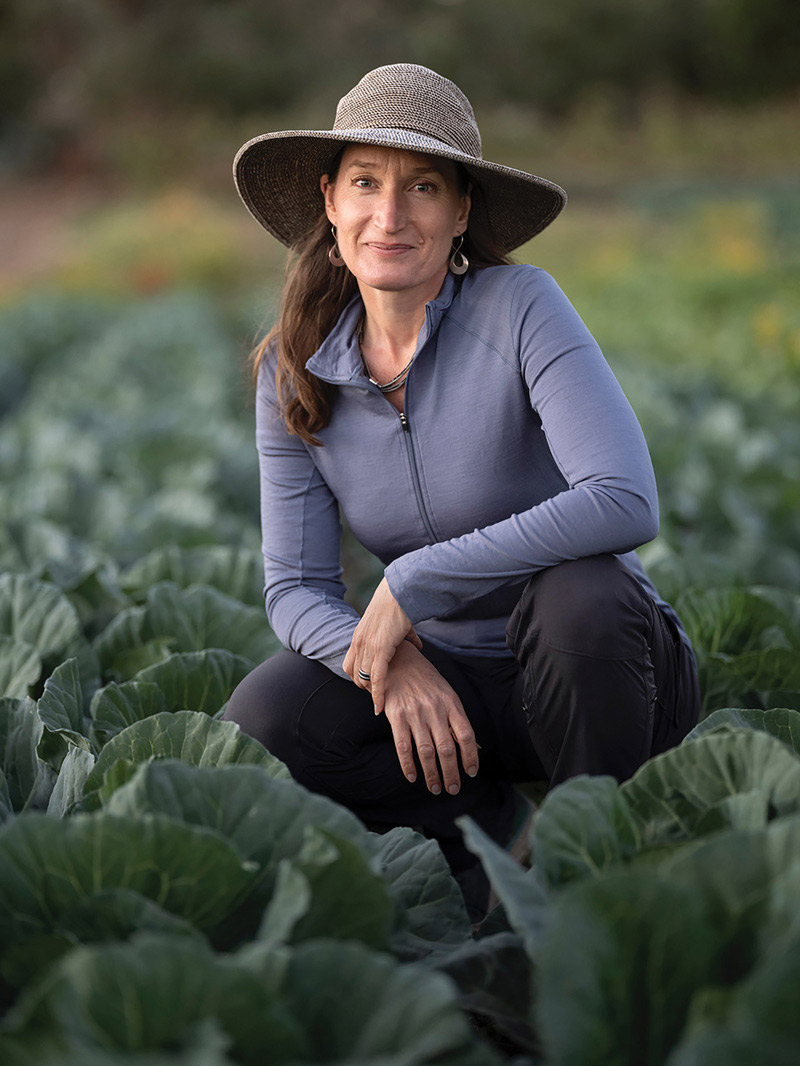 Explaining her documentary work of people around the world, she says, “When I’m photographing someone, I immerse myself in their world and ask questions. Basically, I want to shine love on them. I want them to feel seen and that their work is important. The world should be interested in what they do. I choose subjects that interest me and people who have stories that the world needs to hear. My hope is to photograph people in a way that love comes through.”
Explaining her documentary work of people around the world, she says, “When I’m photographing someone, I immerse myself in their world and ask questions. Basically, I want to shine love on them. I want them to feel seen and that their work is important. The world should be interested in what they do. I choose subjects that interest me and people who have stories that the world needs to hear. My hope is to photograph people in a way that love comes through.”
Andrew Wyeth, a fine artist whose work was often dismissed as illustration, said, “One's art goes as far and as deep as one's love goes."

